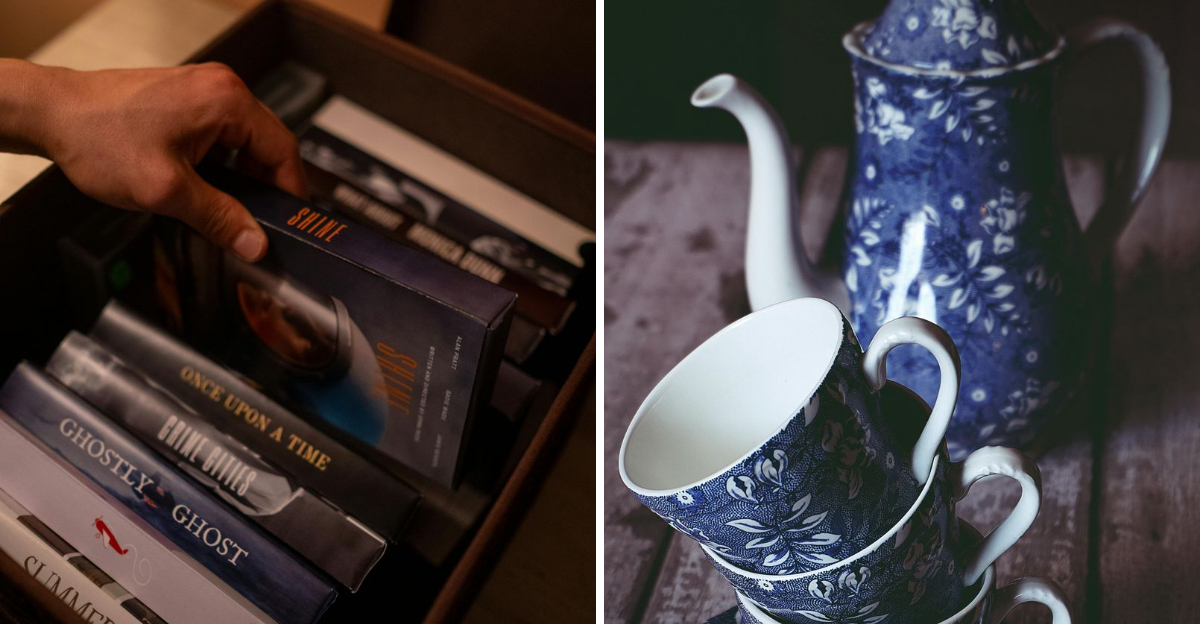14 Common Things Organizers Often Advise Letting Go Of In The Attic

Attics often become the final resting place for items we’re not quite ready to part with. Over time, these forgotten treasures turn into space-hogging clutter that weighs on our minds and homes.
Professional organizers know exactly which items tend to accumulate unnecessarily in these overhead spaces. Ready to reclaim your attic and free yourself from stuff you’ll likely never use again?
The advice provided here is intended for general organization purposes and may not apply to every situation. Professional assistance may be helpful for specific needs.
1. Old Holiday Decorations
Faded plastic Santas and tangled light strings from three decades ago aren’t bringing holiday joy anymore. They’re just collecting dust in crumbling cardboard boxes.
Many families hold onto decorations out of tradition, but be honest-if you haven’t displayed them in the last five years, you probably never will. Keep only the truly meaningful pieces that still enhance your celebrations.
2. Broken Furniture
That chair with the wobbly leg you planned to fix in 2015? It’s time to face reality. Broken furniture pieces take up valuable square footage while serving absolutely no purpose.
The honest truth: most of us lack either the skills, tools, or motivation to complete these repairs. For items with genuine antique value, consult a professional restorer. Otherwise, take photos for memories and say goodbye.
3. College Textbooks
Remember dropping hundreds on those heavy psychology textbooks? Now they’re just collecting dust and taking up space. Information becomes outdated quickly, especially in fields like medicine, technology, and business.
Libraries and schools rarely accept old textbooks these days. Consider selling recent editions online, donating to international book programs, or recycling them. Keep only books that genuinely bring you joy or have practical reference value today.
4. Children’s Artwork Overflow
Your child’s artistic journey is precious, but preserving every scribble isn’t practical. Most parents struggle with the guilt of discarding these paper memories, but keeping everything isn’t sustainable.
Professional organizers recommend selecting representative samples from different ages and stages. Photograph or scan the rest before recycling. Create a digital album or yearly physical book!
5. Outdated Electronics
That collection of VCRs, cassette players, and first-generation iPods isn’t a vintage tech museum-it’s electronic clutter. Technology evolves rapidly, making these items obsolete and essentially worthless.
Beyond taking up space, old electronics can leak chemicals and pose fire hazards. Research electronics recycling programs in your area that safely dispose of components and precious metals.
6. Unused Exercise Equipment
The treadmill that transformed into an expensive clothes hanger isn’t magically going to inspire a fitness revolution from your attic. Exercise equipment is bulky, heavy, and often abandoned after purchase.
Fitness trends and personal goals change over time. If you haven’t used something in a year, you probably won’t start now. You can sell larger items on marketplace sites!
7. Old Suitcases
Hard-shell suitcases from the 1980s with broken wheels aren’t coming on your next vacation. Modern luggage is lighter, more durable, and designed for current travel requirements and restrictions.
Vintage suitcases without practical travel value can find new life as decorative storage or sold to collectors. Truly damaged pieces should be discarded. Keep only luggage you actually use!
8. Incomplete Board Games
Family game night loses its charm when half the Monopoly money is missing or the Trivial Pursuit questions reference current events from 1992. Incomplete games create frustration, not fun.
Before storing games, check that all pieces are present. For incomplete sets, check if replacement parts are available online. Otherwise, recycle what you can and discard the rest.
9. Outdated Clothing
Acid-wash jeans and shoulder-padded blazers aren’t coming back in style, despite what fashion magazines claim. Clothing stored long-term often develops mildew, yellowing, and pest damage, making it unwearable anyway.
Vintage clothing with actual value should be properly preserved in acid-free materials, not stuffed in attic bins. Donate usable items so someone else can enjoy them now.
10. Old Financial Documents
Boxes of bank statements from 2003 aren’t just clutter-they’re potential identity theft risks. Most financial documents don’t need to be kept for more than 7 years, with many needing far less time.
Check with a tax professional about retention requirements for your situation. Shred outdated sensitive documents rather than simply tossing them. Consider scanning important papers for digital backup.
11. Old Media Collections
VHS tapes, cassettes, and CD collections gather dust while you stream everything anyway. These formats degrade over time, especially in attic conditions with temperature fluctuations.
For truly cherished content, consider digital conversion services before the media becomes unplayable. Vintage media sometimes has resale value to collectors, but most mass-produced items won’t be worth the storage space.
12. Unused Craft Supplies
The scrapbooking phase of 2010 left behind a mountain of decorative papers, stamps, and specialized tools you haven’t touched since. Craft supplies are particularly vulnerable to attic conditions-paper yellows, adhesives dry out, and fabrics attract pests.
Be realistic about which hobbies still bring you joy. Donate usable supplies to schools, community centers, or senior facilities where they’ll be appreciated immediately.
13. Inherited Items You Don’t Love
Grandma’s china set that doesn’t match your style isn’t honoring her memory by collecting dust in your attic. Many people store inherited items out of guilt rather than genuine attachment or usefulness.
Honor family connections by keeping only meaningful pieces you truly value. Take photos of other items before finding them new homes where they’ll be appreciated.
14. Old Sports Equipment
Tennis rackets with loose strings and ski gear from your college days take up substantial space while serving no purpose. Sports equipment often has safety components that degrade over time, potentially making items dangerous to use after years in storage.
Evaluate whether you’ll realistically return to these activities. Many items can be rented when needed rather than owned and stored. You can buy used equipment that can be passed along when the season ends.






